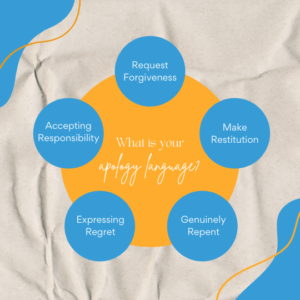
Dr. Gray Chapman, author of the 5 Love Languages now has a tool to help you discover your Apology Language.
Just like we have a preferred way of giving and receiving love, it makes sense that we also have a preferred way of repairing ruptures in relationships through an apology.
The Five Love Languages—acts of service, receiving gifts, quality time, words of affirmation, and touch are different ways in which we express and like to receive affection. When a person says or does something that matches one’s “love language” it can feel good. Same thing with apology languages.
But…if there is a mismatch, it can drive a wedge further in the relationship.
Have you ever made a sincere apology only to feel like it wasn’t “enough” or worse yet, not accepted? If so, chances are learning about what-it-takes-to-give-and-receive-a-good-apology would be helpful! Below is a brief description of the 5 Apology Languages, that coincide with the communication styles of the five love languages.
Let’s use a basic scenario. You scheduled a dinner reservation for a [friend/ partner] for 7 PM and get a text that they are just leaving work and won’t be back in time and will need to reschedule last minute. What would an apology look like?
1. Accepting Responsibility
If you scored high in accepting responsibility, you likely would like the other person to admit their wrongdoing and accept responsibility. This is tough when egos and pride are in the way.
An example apology would look like this: “I take full responsibility for missing our reservation. I am sorry.”
2. Expressing Regret
If you scored high in expressing regret, you are likely seeking a sincere apology, expressed through words and body language that takes ownership of the hurt caused to repair the relationship.
An example apology would look like this: “I am sorry that I won’t be back in time for our reservation”. I know that you were really looking forward to dinner out.”
3. Genuinely Repent
If you scored high in genuinely repenting, you likely are seeking a sincere apology along with admittance of wrong and a desire to change. There is an element of vulnerability with repentance. The key to success here is taking continual steps toward the desired change.
An example apology would look like this: “I feel bad about how I managed my time and don’t like it when I am not able to be there for you. Can we talk about some ways to help prevent this from happening again?”
4. Make Restitution
If you scored high in making restitution, you likely want the person who wronged you to pay by justifying their actions to “make amends” along with a sincere apology. By learning what the other’s Love Language is, restitutions will be most effective.
An example apology would look like this: “I am so sorry, how can I make this up to you?”
5. Request Forgiveness
If you scored high in requesting forgiveness, you likely want to hear the other person ask for your forgiveness. This is viewed as a sign that they have realized their wrongdoing. This is another area that is not easy due to being vulnerable to rejection.
An example apology would look like this: I am sorry for missing dinner. “I value our relationship and hope that you will forgive me.”
A final thought…
While apologies can be hard, so too can the choice to forgive. Within all the apology languages, there is an element of sincerity, genuineness, vulnerability, and mutual respect within the relationship. Demanding an apology, giving an ultimatum, “making” the other person “pay” for their wrongdoings, using guilt or shame to manipulate an apology, and blaming others will all ultimately further rupture the relationship.
Written By: Charlotte Johnson, MA, LPCC
We’re Here to help
Our wellness experts will be happy to take care of you. You can CLICK HERE to schedule an appointment now or call (612)223-8898.
Meet Clinicians
We’re united by our commitment to providing effective, relevant, and innovative mental health support at all stages of your journey. Click Here to find out more about who we are, where we come from, and how we live out CARE’s mission every day.
The professionals at CARE are actively collecting and creating resources to help with what you need. We’re Here for You.



